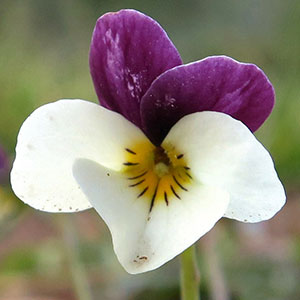Viola hallii
Viola affinis
Hall's violet, Oregon violet, wild pansy
Le Conte's violet, sand violet, violette affine
1–3, decumbent or ascending to erect, ca. 1/2 subterranean, glabrous, clustered on single, short, vertical, deep-seated caudex.
basal and cauline;
basal: 1–4, palmately compound, ± 2-ternate or 3-ternate, leaflets 3;
stipules adnate to petiole, forming 2 linear-lanceolate wings, unlobed, margins entire, apex of each wing free, acute;
petiole 5–8 cm, glabrous;
blade ovate to deltate, 2.8–6 × 2.6–6.5 cm, ± coriaceous, base tapered, ultimate lobes narrowly elliptic, lanceolate, or oblanceolate, 1–7 mm wide, margins entire, ciliate or eciliate, apex acute, mucronulate, surfaces glabrous;
cauline similar to basal except: stipules usually lanceolate, sometimes broadly ovate, ± leaflike, margins toothed;
petiole 1.3–6 cm;
blade 2–4.8 × 1.2–5.5 cm.
basal, 1–6, ascending to erect;
stipules lanceolate, margins entire or fimbriate, apex acute;
petiole 2–10 cm, glabrous;
blade green abaxially, unlobed, narrowly to broadly ovate or narrowly deltate, 1.5–10 × 1.5–10 cm, not fleshy, base cordate to broadly cordate or almost truncate, margins crenate to serrate, ciliate or eciliate, apex acute to obtuse, surfaces sparsely pubescent adaxially, rarely glabrous.
2.5–11 cm, glabrous.
3–15 cm, glabrous or pubescent.
sepals lanceolate to ovate, margins ciliate, auricles 0.5–1 mm;
petals: upper 2 almost black abaxially, dark reddish violet adaxially, lower 3 pale yellow, cream, or ± white, lateral 2 bearded, with deep yellow to orange patch basally, dark reddish violet-veined, lowest with deep yellow to orange patch basally, dark reddish violet-veined, 5–18 mm, spur yellow, gibbous, 0.5–2 mm;
style head bearded; cleistogamous flowers absent.
sepals lanceolate to ovate, margins ciliate or eciliate, auricles 1–2 mm;
petals lavender-violet to dull reddish violet on both surfaces, lower 3 white basally and darker violet-veined, lateral 2 bearded, lowest 10–22 mm, usually obviously bearded, rarely beardless, spur white or same color as petals, gibbous, 2–3 mm;
style head beardless; cleistogamous flowers from prostrate to ascending peduncles.
ellipsoid, 4–12 mm, glabrous.
often reddish or purplish-flecked or green, ellipsoid, 5–10 mm, glabrous or puberulent.
light brown, shiny, 3.2–3.5 mm.
beige, mottled to bronze, 1.5–2.5 mm.
= 60, 72.
= 54.
Viola hallii
Viola affinis
Viola hallii was discovered on the grounds of Willamette University in Salem, Oregon, by Elihu Hall, a professor at that institution (V. B. Baird 1942). Leaves of V. hallii are similar to V. beckwithii.
(Discussion copyrighted by Flora of North America; reprinted with permission.)
L. E. McKinney (1992) considered Viola affinis, and much of what botanists had called V. nephrophylla, to be essentially the same taxon. After studying additional specimens, reviewing literature (H. E. Ballard 1994; A. Haines 2001b), and discussions with others (J. Cayouette, H. E. Ballard, A. Haines, pers. comm.), he chose to maintain these as separate taxa. Reports of V. affinis in the Gulf coastal states based on specimens or photographs are usually attributable to V. missouriensis.
Viola affinis reportedly hybridizes with V. hirsutula (= V. ×consobrina House), V. cucullata (= V. ×consocia House), V. brittoniana (= V. ×davisii House), V. sororia (= V. ×filicetorum Greene [as species]), V. sagittata var. sagittata (= V. ×hollickii House), and V. nephrophylla (= V. ×subaffinis House).
(Discussion copyrighted by Flora of North America; reprinted with permission.)


